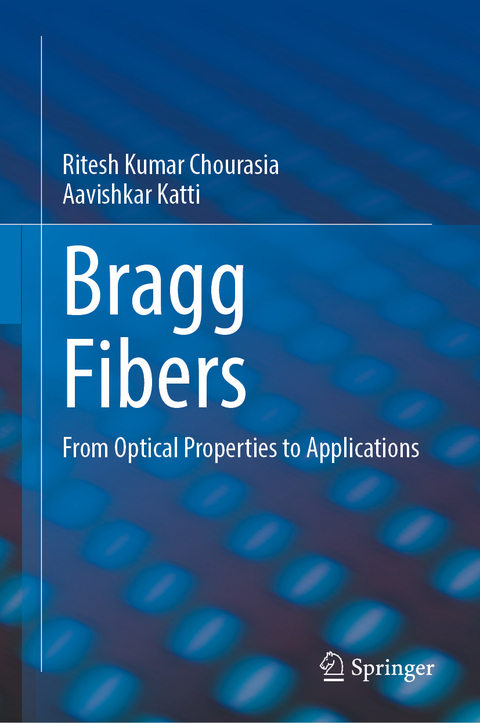
Bragg Fibers
Springer International Publishing (Verlag)
978-3-031-65163-2 (ISBN)
This book highlights the guiding mechanisms as well as the most current and important results in the field of innovative, bio-inspired Bragg fibers. While conventional optical fibers (COF) have several advantages over traditional waveguides, they also suffer from a number of disadvantages which are not present in Bragg fibers due to their minimal nonlinearities, lack of polarization or birefringence effect, lack of Fresnel reflections at the open fiber end, and absence of material or cladding losses. A natural platform for biological and chemical sensing, and with potential to boost communication systems' speed and bandwidth, the primary goal of this book is to apprise readers in academia and industry of properties of EM wave propagation in Bragg fibers with a defect layer. Their major applications in bio/chemical sensing, fuel adulteration sensing, high-temperature sensing, optical dual-channel inline filtering, optical de-multiplexers, optical couplers, and nonlinear soliton generation are presented in detail, along with comparisons of Bragg fibers with alternative structures and their relative pros and cons.
Ritesh K. Chourasia earned his Master's in Physics (Specialization: Electronics) and Ph.D. from the Institute of Science, Banaras Hindu University (Varanasi, India). His doctoral research work was on Bragg fiber's mathematical modeling, simulation, and exploration of their optical properties in various applications. He qualified for the highly competitive exam CSIR-JRF (Junior Research Fellow) in Physical Sciences to obtain a national fellowship for his Ph.D. and eligibility required for permanent faculty in India. He has also qualified for UGC-NET in Electronic Sciences, an international examination GATE-Physics, and JEST-Physics. He joined as Assistant Professor (Permanent) at Lalit Narayan Mithila University, Darbhanga-846004, in 2017, and presently he is working as Head, Post-Graduate Department of Physics, Samastipur College, Samastipur-848134 (A Constituent College of L.N. Mithila University, Darbhanga, 846004). He has published numerous quality research papers, review articles, and book chapters in international journals and publishers of repute. He has also two granted Indian patents on Bragg fibers. He is currently supervising four Ph.D. students and also has supervised numerous Master's dissertations. He has also served as guest editor and is involved in the Editorial board of many indexed journals. Currently, his prime research interest is non-linear aspects of Bragg fibers, Bragg fiber gratings, and photonic crystals.
Aavishkar Katti earned his Bachelor's and Master's degrees in Physics with a specialization in optics and spectroscopy from the University of Delhi (Delhi, India). He then completed his Ph.D. from the Banaras Hindu University (Varanasi, India). His doctoral research work was on optical solitons in nonlinear optical materials. He has qualified for the intensely competitive National Eligibility Test required for a teaching position in India. He has been associated with Banasthali Vidyapith and now MIT World Peace University as Assistant Professor of Physics. His areas of interest include nonlinear optics and nonlinear dynamics. He has published in many reputed and indexed journals and has a track record of robust independent research. He has supervised many Masters's and Doctoral students. He has published a research monograph on Optical Solitons previously while he also has edited books to his credit. He has served as guest editor and is on editorial board of reputed and indexed journals. In recognition of his research, he has been awarded with research grants from the Govt. of India, including the prestigious Core Research Grant.
Chapter 1. Introduction to Bragg fiber.- Chapter 2. Multi-layered and Multi-material Fabrication Techniques and Detailed Processes For Bragg Fibers.- Chapter 3. Various analytical techniques, theorems, and formalisms.- Chapter 4. Optical properties of symmetrical Bragg fiber: periodic structures.- Chapter 5. Optical properties of asymmetrical Bragg fiber: with defect.- Chapter 6. Multifunctional Bragg fibers: to see, hear, sense, and communicate simultaneously.- Chapter 7. Optofluidic Bragg Fiber Sensor Applications: Fuel Adulteration Sensor (Perceiving in Chemically Diverse Environments).- Chapter 8. Bragg fiber optoelectronic applications: Optical inline filters for multiwavelength applications.- Chapter 9. Bragg Fiber: Some Nonlinear Aspects.
| Erscheinungsdatum | 03.09.2024 |
|---|---|
| Zusatzinfo | XXI, 172 p. 62 illus., 60 illus. in color. |
| Verlagsort | Cham |
| Sprache | englisch |
| Maße | 155 x 235 mm |
| Themenwelt | Technik ► Elektrotechnik / Energietechnik |
| Schlagworte | Bragg fiber • fiber sensors • Hollow core optical fiber • Nonlinear Optics • Optical fiber • Photonic band gap • Photonic Crystal Fiber • Solitons |
| ISBN-10 | 3-031-65163-4 / 3031651634 |
| ISBN-13 | 978-3-031-65163-2 / 9783031651632 |
| Zustand | Neuware |
| Haben Sie eine Frage zum Produkt? |
aus dem Bereich


